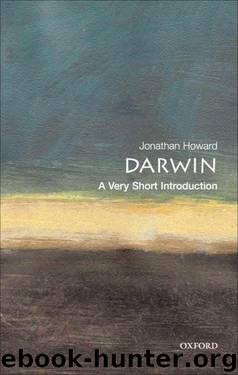Darwin: A Very Short Introduction (Very Short Introductions) by Howard Jonathan

Author:Howard, Jonathan [Howard, Jonathan]
Language: eng
Format: mobi, epub
Publisher: Oxford University Press
Published: 2001-02-21T16:00:00+00:00
6. The final form of the thought pictures shown in chapter 3 and the only illustration in the Origin of Species. The diagram depicts the evolution of ancient lineages A–L from ancient times (bottom) to the present (top). In each stage (Roman numerals) a species can either stay the same, branch into new species, or go extinct. Notice that all the modern forms have arisen from lineages A and I, with the single exception of F which transmits a largely unaltered form to the present, a ‘living fossil’. Everything else has gone extinct.
However, if the imperatives of selection favour highly adaptive modification of early developmental stages to the external environment there is no necessary obstacle to its occurrence. As Darwin pointed out, in many organisms larval stages are functionally equipped quite differently from the adult and serve entirely distinct roles in the life of the species, as with caterpillars and butterflies. What Darwin did not understand, except perhaps in the most general terms, was that development is a complex interactive process and is strongly resistant to variation, just as the adaptation of a species to its niche is complex and interactive and is, in general, intolerant of dramatic change. A new variation is thus subject to selection not merely in its effects on the adult structure, but even more so in its ability to permit organized embryonic development at all. Because the unravelling of form in embryonic life is arranged sequentially, the earlier in embryonic life a variation is expressed, the more drastic are its consequences for development. Embryos are thus inherently conservative and strategies of embryonic development are remarkably consistent within very large groups of organisms. The phenomenon of homology, or correlated structures, reflects this conservatism, and Darwin was certainly right in arguing that homological similarities indicated common ancestry.
Although the main argument of the Origin of Species can be presented easily enough, no such synopsis can display the intellectual intensity of the whole. The idea of a tree-like arrangement of organisms was common currency before Darwin. Darwin’s development of this metaphor in genealogical terms illustrating the relationship between the variation and extinction of organisms united by the bond of inheritance through time will serve to summarize the main conclusions of the Origin of Species:
Download
Darwin: A Very Short Introduction (Very Short Introductions) by Howard Jonathan.epub
This site does not store any files on its server. We only index and link to content provided by other sites. Please contact the content providers to delete copyright contents if any and email us, we'll remove relevant links or contents immediately.
Hit Refresh by Satya Nadella(9083)
When Breath Becomes Air by Paul Kalanithi(8368)
The Girl Without a Voice by Casey Watson(7843)
A Court of Wings and Ruin by Sarah J. Maas(7729)
Do No Harm Stories of Life, Death and Brain Surgery by Henry Marsh(6905)
Shoe Dog by Phil Knight(5217)
The Rules Do Not Apply by Ariel Levy(4910)
A Higher Loyalty: Truth, Lies, and Leadership by James Comey(4906)
Hunger by Roxane Gay(4893)
Tuesdays with Morrie by Mitch Albom(4729)
Everything Happens for a Reason by Kate Bowler(4701)
The Immortal Life of Henrietta Lacks by Rebecca Skloot(4550)
Millionaire: The Philanderer, Gambler, and Duelist Who Invented Modern Finance by Janet Gleeson(4421)
How to Change Your Mind by Michael Pollan(4315)
All Creatures Great and Small by James Herriot(4271)
The Money Culture by Michael Lewis(4134)
Man and His Symbols by Carl Gustav Jung(4094)
Elon Musk by Ashlee Vance(4084)
Tokyo Vice: An American Reporter on the Police Beat in Japan by Jake Adelstein(3950)
